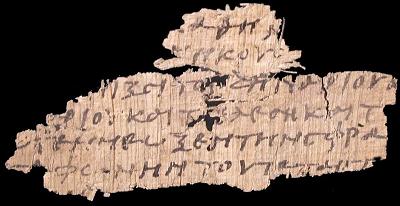| Change to Book/Chapter View |
|
|
|
Translation process is ongoing. For current status see details |
|
|

Papyrus 24 Discovered: Oxyrhynchus, Egypt Location: Newton Center, Massachusetts: Franklin Trask Library Contents: Revelation 5:5-8, 6:5-8 Notes: Written on a large leaf, probably part of a church Bible, though written by an untrained scribe.
Revelation 5 5 One of the elders said to me, “Don’t weep. Behold, the Lion who is of the tribe of Judah, the Root of David, has overcome: he who opens the book and its seven seals.” 6 I saw in the middle of the throne and of the four living creatures, and in the middle of the elders, a Lamb standing, as though it had been slain, having seven horns and seven eyes, which are the seven Spirits of God, sent out into all the earth. 7 Then he came, and he took it out of the right hand of him who sat on the throne. 8 Now when he had taken the book, the four living creatures and the twenty-four elders fell down before the Lamb, each one having a harp, and golden bowls full of incense, which are the prayers of the saints. [..] Revelation 6 5 When he opened the third seal, I heard the third living creature saying, “Come and see!” And behold, a black horse, and he who sat on it had a balance in his hand. 6 I heard a voice in the middle of the four living creatures saying, “A choenix of wheat for a denarius, and three choenix of barley for a denarius! Don’t damage the oil and the wine!” 7 When he opened the fourth seal, I heard the fourth living creature saying, “Come and see!” 8 And I saw and[i] behold, a pale horse, and the name of he who sat on it was Death. Hades followed with him. Authority over one fourth of the earth, to kill with the sword, with famine, with death, and by the wild animals of the earth was given to him.
|
How to read these pages: • The
translation to the left is based on the World English Bible. Words in regular
black font are words in the manuscript matching the Majority Text for that
passage. • Words
in italics cannot be seen in the manuscript, since the manuscript is
fragmentary. These words are supplied for readability by the World English
Bible translation. • Words
present in the manuscript but with some letters unreadable or missing are in blue
like this: blue. One Greek word often is
translated into multiple English words, and when this occurs, all the English
words are in blue. • Words
present in the manuscript but with spelling or trivial word order differences that do not affect the
meaning are in green like this: green. • If
the manuscript is different from the Majority Text, words in the Majority
Text that are missing from the text of the manuscript are marked through in red
like this: • If the manuscript is different from the Majority Text, words in the manuscript that are not in the Majority Text are underlined in red like this: new words.If the manuscript differs from the Majority Text yet matches another well-known text, this is noted in the footnotes.
|
